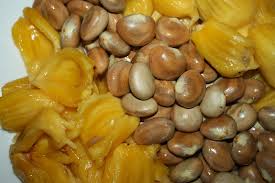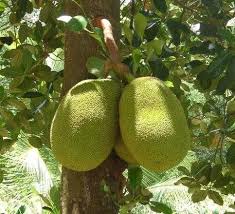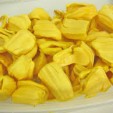The flesh of the jackfruit is starchy and fibrous and is a source of dietary fiber. The flavor is comparable to a combination of apple, pineapple, mango and banana.
Nutritional Benefits: The edible jackfruit is made of soft, easily-digestible flesh (bulbs); A portion of 100 g of edible raw jackfruit provides about 95 calories and is a good source of the antioxidant vitamin C, providing about 13.7 mg.[21] Jackfruit seeds are rich in protein.
Seeds:  In general, the seeds are gathered from the ripe fruit, sun-dried, then stored for use in rainy season in many parts of South Indian states. Boiled Jackfruit seed is also edible. Seasoned with nothing more than salt, this snack is very delicious. I used to boil and roast the jackfruit seeds as a child in Jamaica. This is one of my favorite fruits. I eat it at every trip to Jamaica.. love it, love it, love it.
In general, the seeds are gathered from the ripe fruit, sun-dried, then stored for use in rainy season in many parts of South Indian states. Boiled Jackfruit seed is also edible. Seasoned with nothing more than salt, this snack is very delicious. I used to boil and roast the jackfruit seeds as a child in Jamaica. This is one of my favorite fruits. I eat it at every trip to Jamaica.. love it, love it, love it.
Ripe jackfruit is naturally sweet with subtle flavoring. It can be used to make a variety of dishes, including custards, cakes, halo-halo and more. In India, when the Jackfruit is in season, an ice cream chain store called “Naturals” carries Jackfruit flavored ice cream.
Ripe jackfruit arils are sometimes seeded, fried or freeze-dried and sold as jackfruit chips. There are many Culinary uses for the ripe fruit. check out these vegan jackfruit recipes: 13 Stellar Vegan Jackfruit Recipes 
| Nutritional value per 100 g (3.5 oz) | |
|---|---|
| Energy | 397 kJ (95 kcal) |
| Carbohydrates | 23.25 g |
| – Sugars | 19.08 g |
| – Dietary fiber | 1.5 g |
| Fat | 0.64 g |
| Protein | 1.72 g |
| Vitamin A equiv. | 5 μg (1%) |
| – beta-carotene | 61 μg (1%) |
| – lutein and zeaxanthin | 157 μg |
| Thiamine (vit. B1) | 0.105 mg (9%) |
| Riboflavin (vit. B2) | 0.055 mg (5%) |
| Niacin (vit. B3) | 0.92 mg (6%) |
| Pantothenic acid (B5) | 0.235 mg (5%) |
| Vitamin B6 | 0.329 mg (25%) |
| Folate (vit. B9) | 24 μg (6%) |
| Vitamin C | 13.7 mg (17%) |
| Vitamin E | 0.34 mg (2%) |
| Calcium | 24 mg (2%) |
| Iron | 0.23 mg (2%) |
| Magnesium | 29 mg (8%) |
| Manganese | 0.043 mg (2%) |
| Phosphorus | 21 mg (3%) |
| Potassium | 448 mg (10%) |
| Sodium | 2 mg (0%) |
| Zinc | 0.13 mg (1%) |
| Link to USDA Database entry Percentages are roughly approximated using US recommendations for adults. Source: USDA Nutrient Database |
|

